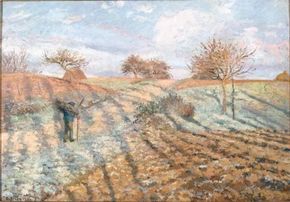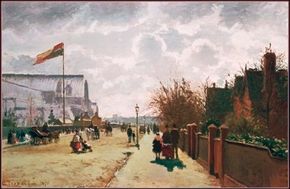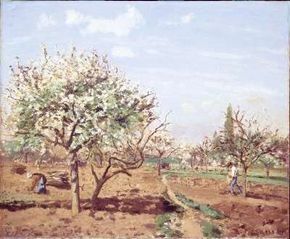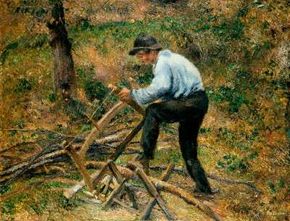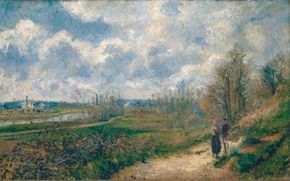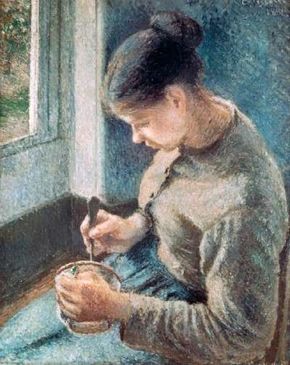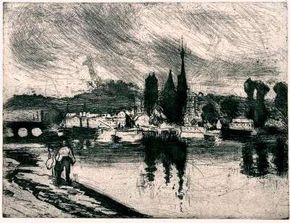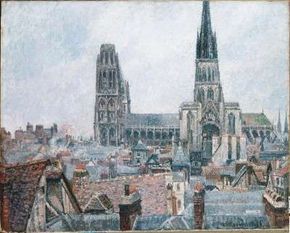Camille Pissarro was one of the original circle of painters who would become known as the Impressionists. In the 1860's Pissarro, along with Paul Cézanne, Claude Monet, Pierre-Auguste Renoir, and Frédéric Bazille, debated issues and shared ideas with Edouard Manet at the Café Guerbois near Manet's studio in the rue de Batignolles. Pissarro -- the only one of the Impressionists to show at all eight exhibitions -- quickly became famous for his plein air technique, evidenced in masterpieces such as the 1873 work Hoarfrost.
Later, when the Impressionists became a major force in the art world, it was Camille Pissarro who advocated most strongly for the new generation of progressive artists, supporting young painters such as Paul Gauguin and Georges Seurat.
Advertisement
By the time the eighth and final exhibition arrived, Pissarro was already beginning to experiment with new techniques which critics were to call Neo-Impressionism. To the end, Camille Pissarro remained the most experimental, always open to new influences and always supportive of young, struggling artists. However, he never fully abandoned his attachment to plein air painting.
Please follow the links below to learn more about some of the paintings by the innovative Impressionist, Camille Pissarro.
- Hoarfrost: Camille Pissarro's Hoarfrost is an example of Pissarro's dedication to plein air painting. Learn about Hoarfrost, which Camille Pissarro painted in 1873.
- The Crystal Palace: Pissarro painted The Crystal Palace while abroad during the Franco-Prussian War. Learn about The Crystal Palace, which Pissarro painted while in London.
- Chennevières on the Banks of the Marne: Chennevières on the Banks of the Marne evidences the influence of the Barbizon School upon Pissarro's approach. Learn about Camille Pissarro's Chennevières on the Banks of the Marne.
- Orchard in Bloom, Louveciennes: Camille Pissaro's Orchard in Bloom, Louveciennes resulted from Pissarro's stay in a small village west of Paris. Find out about Pissarro's Orchard in Bloom, Louveciennes.
- Edge of the Woods: Pissarro's 1879 work Edge of the Woods was shown at the fourth Impressionist exhibition. Learn about Edge of the Woods, which is also known as Undergrowth in Summer.
- The Woodcutter: The Woodcutter by Camille Pissarro is typically Impressionist in its interest in depicting lives of the peasants. Learn about the 1879 painting The Woodcutter.
- Pathway at Chou in March: Pathway at Chou in March shows Pissarro's mastery of the plein air technique. Learn about Camille Pissarro's painting Pathway at Chou in March.
- Café au Lait: Camille Pissarro's work Café au Lait is noted for its intimacy and composition. Read about Café au Lait by Camille Pissarro.
- View from My Window, Eragny: View from My Window, Eragny marks a new direction in Pissarro's career. Learn about View from My Window, Eragny.
- View of Rouen (Cours-la reine): Pissarro's View of Rouen (Cours-la reine) demonstrates Pissarro's ability to work in different media. Find out about View of Rouen, which is an etching.
- The Roofs of Old Rouen, Gray Weather: The Roofs of Old Rouen, Gray Weather, was one of Camille Pissarro's last major Impressionist paintings. Learn about the 1896 painting The Roofs of Old Rouen, Gray Weather.
On the next page, we'll take a closer look at Camille Pissarro's Impressionist painting, Hoarfrost.
For more on Impressionist paintings, artists, and art history, see:
For more on Impressionist paintings, artists, and art history, see:
Advertisement
